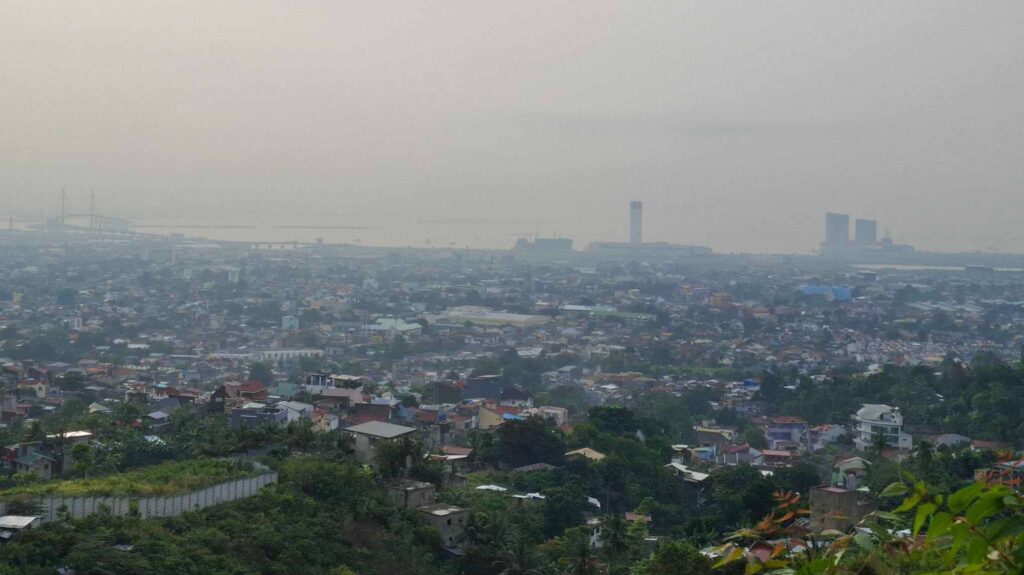EXPLAINER: Haze in Cebu City; How and why it happened?

A photo taken on Thursday, Nov. 14, shows a slight haze hovering over the skyline of Cebu City, as earlier confirmed by Pagasa-Mactan. | Photo by Paul Lauro
CEBU CITY, Philippines – On Thursday morning, November 14, 2024, residents here woke up to hazy skies, prompting local authorities to urge those with health problems to take precautions.
The light haze observed in Cebu City was due to climate-induced air pollution, the Environmental Management Bureau in Central Visayas (EMB-7) confirmed.
EMB-7 verified with Philippine Atmospheric Geophysical and Astronomical Services Administration (Pagasa) in Mactan that the haze was caused by another meteorological phenomenon called temperature inversion.
The agency also clarified that the haze was not due to continuous degassing of the nearby Mt. Kanlaon.
Volcanic gasses emitted into the sky often result in haze.
“Walang other countries na nagreport na merong forest fires. There’s also no gas-related air pollution,” added Abrera.
Haze in Cebu: How it happened?
Citing findings from Pagasa, temperature inversion observed in Cebu City prevented air pollutants and other dry particles from entering into the upper layers of the atmosphere.
As a result, they were trapped within the ‘breathable level’ of the atmosphere, creating a haze, Abrera said.
In normal weather, air temperature gradually drops as altitude increases. When this relationship is reversed, meteorologists then call this phenomenon as temperature inversion.
READ MORE
Haze: What health risks does it pose?
Light haze blankets Cebu City, Pagasa confirms
During temperature inversions, the layer of colder air is trapped underneath the layer of warmer air. It also prevents dust, smoke and other air pollutants from diffusing and in turn, form to create haze.
In addition, the temperature inversion that caused the formation of haze in Cebu City was triggered by the series of typhoons that recently passed through the Philippines, said Abrera.
“There have been typhoons, very frequent in the same area and in the same period. So ating temperature, they prevented the tiny particles to go up and disperse that quick,” she explained.
Is it safe?
The light haze in Cebu City had been going on since Wednesday, Nov. 13, according to Pagasa-Mactan.
Data from EMB-7 corroborated this when it showed that the volume of air pollutants in the air had recently spiked.
On November 12, they recorded 32 micrograms per cubic meter but on November 14, it doubled up to 65 micrograms per cubic meter.
Nevertheless, EMB-7 assured the public that the air in Cebu City remained safe for breathing but they cautioned those with respiratory issues to protect themselves.
“It’s not alarming. It’s not serious (threats)… Wala pa tayong precautionary measure but for the vulnerable sector. For our senior, our children… they can wear masks for protection,”
Abrera said their monitoring station reported ‘fair air quality’ as of Thursday.
“It is still within the (safe) standard of 150 micrograms per cubic meter,” she explained.
Haze occurs when quantities of extremely small, dry particles that are invisible to the naked eye remain suspended in the air, and therefore create an opalescent appearance, according to the World Meteorological Organization.
Earlier, Pagasa-Mactan said the haze will likely prevail in Cebu City on Friday, November 15, citing the absence of strong wind that would help dissipate the pollutants. / with reports from Futch Anthony Inso
Disclaimer: The comments uploaded on this site do not necessarily represent or reflect the views of management and owner of Cebudailynews. We reserve the right to exclude comments that we deem to be inconsistent with our editorial standards.
